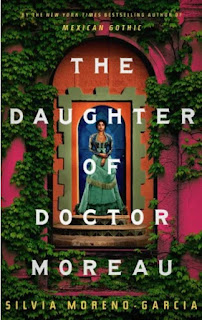The Daughter of Doctor Moreau - A Review
When I first dove into Silvia Moreno-Garcia's work, The Daughter of Doctor Moreau, I was convinced that I would be reading a prequel describing something that happened to Doctor Moreau before he came to be on his island - the one described in the original novel by H.G. Wells. But this was not at all the case. This work is a different version of the Moreau mythos, though not necessarily original.
Variations on Wells' work have been done before. The classic 1932 film The Island of Lost Souls is one example. Another film made in 1977 starring Burt Lancaster and Michael York brought back the original title, but also introduced the idea that Moreau had a daughter, named Maria, which was something not found in Wells' book. The idea of Moreau having a daughter was revisited in the 1996 remake starring Marlon Brando and David Thewlis. This time, his daughter is named Aissa. That film was also landmark in that it used the modern twist of DNA infusion instead of vivisection to create human-animal hybrids.
Revisions of this tale have also been abundant in literature. Brian Aldiss' novel, Moreau's Other Island (1980) is one such example. Sherlock Holmes: The Island of Doctor Moreau by Guy Adams (2012) pits Holmes and Watson against several of Moreau's human-animal creations.
This time, however, Moreau is dwelling in the Yucatan peninsula. Not an island, per se, but so remote that it has often been called an island, which is what inspired Moreno-Garcia to make that her setting.
The story is told from the daughter's perspective. She is named Carlota this time, and the Yaxaktun settlement is her entire world. She is actually friends with some of her father's hybrid creations, especially Lupe and Cachito, who are her best friends. Moreau has a patron, Fernardo Lizdale, who bankrolls Moreau's experiments on the hope of creating an army of cheap, slave labor. But his son, Eduardo, eventually takes an interest in the beautiful Carlota. This causes Lizdale a great degree of angst, as Carlota is a bastard child who would bring dishonor on his house. The budding romance is also unwelcome news for Moreau's drunken Majordomo, Montgomery, who is frustrated because he also has feelings for her. Complicating this is the fact that Moreau insists his daughter is very sick, and that without a special medicine which only his laboratory can provide, she will become ill and die.
Carlota and Eduardo nearly elope, but Lizdale forbids it. After accusing Moreau of squandering his money on frivolous experiments, he brings his own private army to bear an Yaxaktun, and a fierce battle ensues. In the midst of all this, Carlota learns that she is also one of Moreau's hybrids. She has a human mother, but she is also part jaguar. The story ends with several surprising twists.
There is some interesting interplay with this variation. For starters, it is thoroughly 19th-century Mexican. It is also more of a pure romance novel, with some steamy scenes between Carlota and Eduardo thrown in to spice things up a bit. Like other versions of the story, the cat-human hybrid angle takes center stage towards the end, though there are convenient liberties taken. For example, Carlota morphs into a human with night-vision, clawed hands, and sharpened teeth, but does not develop other traits such as six nipples and a tail. Or if she does, Moreno-Garcia does not bother to tell us. Perhaps that's just as well.
In the end, this book treads far too much upon ground which has been trodden on many times before. The emphasis on Mexican culture, while refreshing, seems a bit forced. The jaguar/woman hybrid angle has been done to death, and every reader already knows the hybrids are destined to run off into the forest.
Yet some of the originalities truly stand out. The friendship between Carlota, Cachito, and Lupe is truly special. Having Moreau's laboratory attacked by an army is unique. And Moreau himself suffers a surprising fate which the reader will not see coming. Oddly, the most human out of all the characters by far is, not Moreau, or the love-struck Eduardo, but the drunkard Montgomery, whose character is far more thought out than in any other version of the Moreau tale I've yet found.
This is a pleasant read, especially for those who want more cosmos Latinos in their life.
Eric
**




Comments
Post a Comment